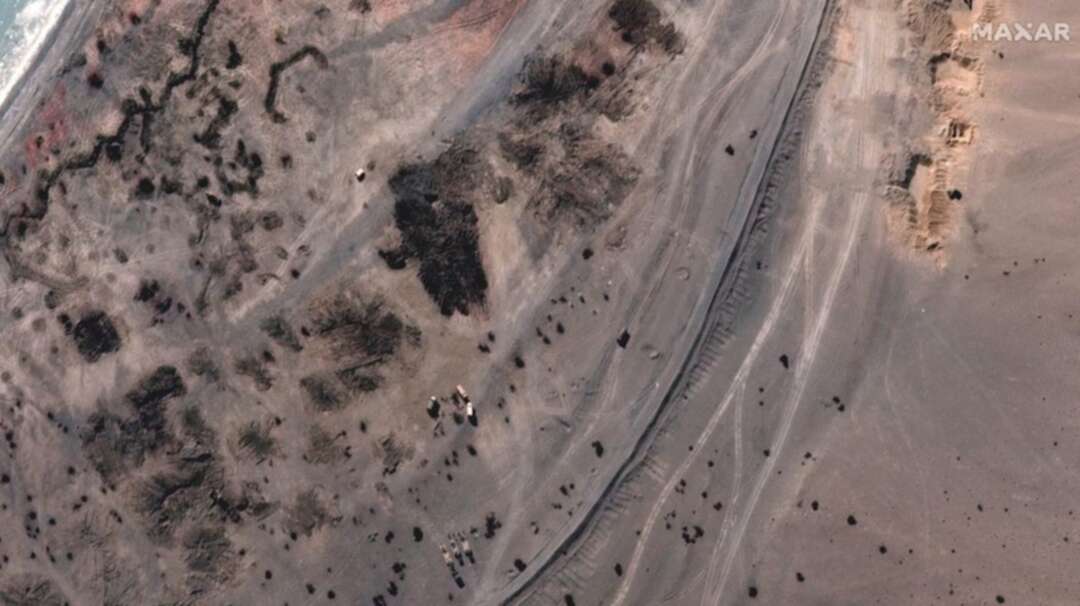-
Satellite images show China vacating military camps at border flashpoint with India

China has dismantled dozens of structures and moved vehicles to empty out entire camps along a disputed Himalayan border, where Indian and Chinese troops have been locked in a face-off since last summer, satellite images released on Wednesday show.
The nuclear-armed neighbors last week announced a plan to pull back troops, tanks and other equipment from the banks of Pangong Tso, a glacial lake in the Ladakh region, that became a flashpoint in the prolonged border dispute.
Satellite imagery of some areas on the northern bank of Pangong Tso from Tuesday supplied by Maxar Technologies show that multiple Chinese military camps, which could be seen there in late January, have been removed.
“Similar action is happening from our side also,” an Indian official in New Delhi, who asked not to be named, told Reuters.
 A view of Pangong Tso lake in Ladakh region. (Reuters)
A view of Pangong Tso lake in Ladakh region. (Reuters)India’s defense minister Rajnath Singh told parliament that both sides had agreed to pull back troops in “a phased, coordinated and verified manner” around Pangong Tso, after which military commanders would discuss ending the standoff in other parts of the Ladakh frontier.
Tensions began rising along the high-altitude border in April, when India accused Chinese troops of intruding into its side of the Line of Actual Control, the de facto border. China denied the allegation, saying it was operating in its own area.
But the confrontation spiraled in June when 20 Indian soldiers and an undisclosed number of Chinese troops were killed during hand-to-hand clashes in Ladakh’s Galwan region -- the first such casualties along the 3,500 km long border in decades.
Despite several subsequent rounds of diplomatic and military talks, India and China had been unable to settle on an agreement until February, making the ongoing first phase of the withdrawal critical.
“What is happening now is that wherever troops, especially north and south of Pangong Tso, were in eyeball-to-eyeball contact, they have taken a step back to reduce tensions and pave way for further de-escalation,” the Indian official said.
 An Indian Air Force fighter jet takes off from an airbase in Leh, the joint capital of the union territory of Ladakh bordering China, on September 9, 2020. (AFP)
An Indian Air Force fighter jet takes off from an airbase in Leh, the joint capital of the union territory of Ladakh bordering China, on September 9, 2020. (AFP)Videos and images released by the Indian army earlier this week also showed Chinese troops dismantling bunkers and tents, and tanks, soldier and vehicles moving out as part of the disengagement process.
But some experts have cautioned that current withdrawal is only the first step in a potentially long-drawn out process.
“It is still nowhere near a full disengagement or an agreement on what we should be doing,” India’s former National Security Adviser Shivshankar Menon told The Wire news outlet.
“We need much more than just disengagement. We need a return to the positions before April last year.”
source: Reuters
Image source: Reuters
Levant
You May Also Like
Popular Posts
Caricature
BENEFIT Sponsors Gulf Uni...
- April 17, 2025
BENEFIT, the Kingdom’s innovator and leading company in Fintech and electronic financial transactions service, has announced its sponsorship of the “Innovation and Sustainable Technology Solutions Competition (GU - IST Solutions), hosted by Gulf University at its main campus.
This strategic sponsorship reflects BENEFIT’s active role in advancing technological innovation and fostering sustainable solutions to future challenges. It also seeks to empower Bahraini youth by enhancing their skills, capabilities, and competitiveness in innovation and solution development—contributing meaningfully to the broader goals of sustainable development across all sectors.
As part of BENEFIT’s active involvement in the competition, the company has announced that Hanan Abdulla Hasan, Senior Manager of Public Relations and Communication, will serve on the competition’s supervisory committee. Her upcoming participation reflects BENEFIT’s forward-looking commitment to championing academic and professional excellence.
Commenting on the occasion, Hanan Abdulla Hasan, Senior Manager of Public Relations and Communication at BENEFIT, said, “We are privileged to support this pioneering initiative, which aligns seamlessly with BENEFIT’s enduring commitment to fostering innovation and nurturing the potential of Bahrain’s youth. Our participation is rooted in a deep sense of social responsibility and a firm belief in the pivotal role of innovation in shaping a sustainable future. Through such platforms, we seek to empower the next generation with the knowledge, skills, and foresight required to develop impactful solutions that address future challenges, in line with the United Nations Sustainable Development Goals 2030.”
Dr. Aseel Al Ayash Dean of the College of Engineering in Gulf University commented, “We extend our sincere gratitude to BENEFIT for their generous sponsorship and support of the Innovation and Sustainable Technology Solutions Competition. This contribution plays an instrumental role in helping us achieve the strategic goals of this initiative, namely, cultivating a culture of innovation and sustainability, encouraging efforts that address the imperatives of sustainable development, and enhancing the practical and professional capabilities of our students and participants.”
The event will bring together a diverse spectrum of participants, including secondary school students, university undergraduates, engineers, industry professionals, entrepreneurs, academic researchers, and subject matter experts representing a wide range of disciplines.
The competition seeks to inspire participants to develop and present innovative, sustainable technologies aimed at addressing pressing environmental, social, and economic challenges. It encourages the formulation of business models that integrate advanced technological solutions with core principles of sustainability. Moreover, it serves as a platform for emerging leaders, entrepreneurs, and innovators to contribute to the advancement of the Sustainable Development Goals, promote the ethos of responsible technology, and demonstrate its transformative potential across various sectors.
Attendees will have the opportunity to view a series of project presentations submitted by participants, covering diverse areas such as eco-friendly product design, smart and sustainable innovations, renewable energy technologies, water conservation and management, waste minimisation and recycling, green architectural solutions, and sustainable transportation systems. Outstanding projects will be formally recognised and awarded at the conclusion of the event.
opinion
Report
ads
Newsletter
Subscribe to our mailing list to get the new updates!






















